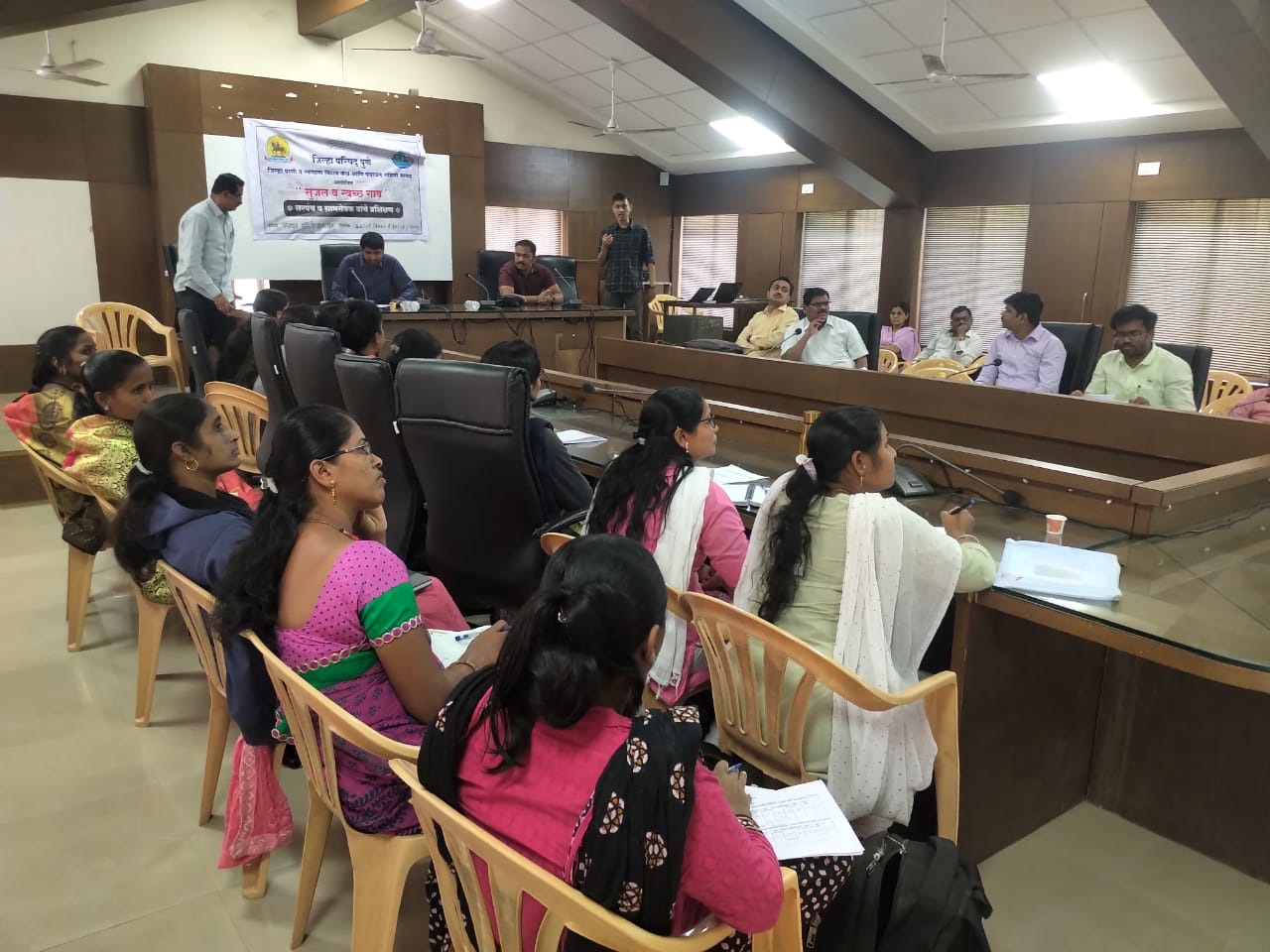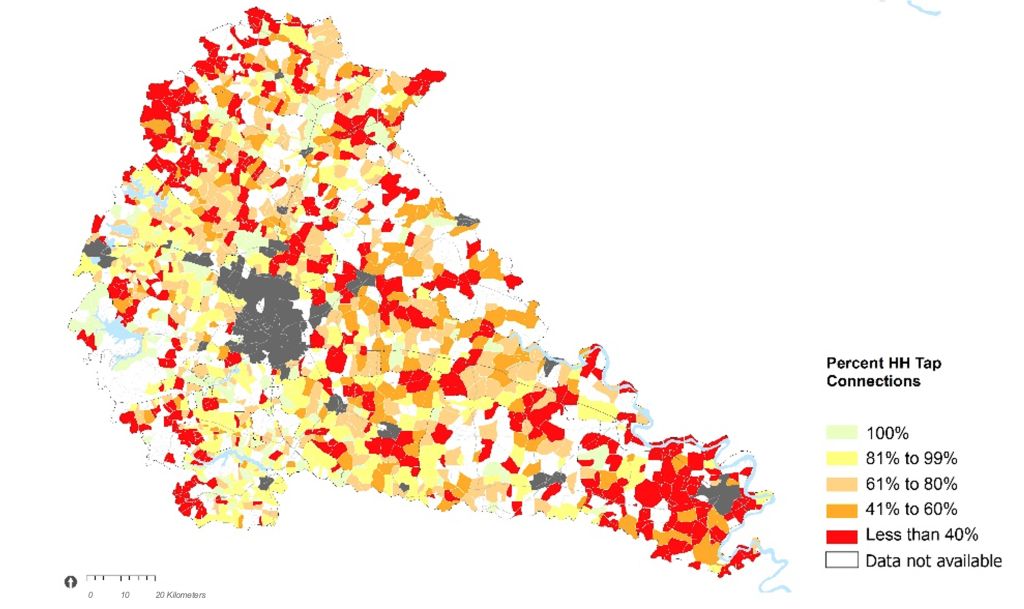
Only about 29% of the 189 million rural households, in India, have potable water supply through household tap connections (Jal Jeevan Mission, September 2020). To address this difference and deficiency in basic services, the Jal Jeevan Mission (JJM) was launched in August 2018 to provide safe and adequate drinking water through Functional Household Tap Connections (FHTCs) to all rural households by 2024.
This goal is sought to be achieved through a bottom-up planning and investment program. The basic planning unit is a revenue village, along with associated habitations. A Village Action Plan is developed for each village through detailed surveys. These VAPs are integrated into District Action Plans (DAPs) and State Action Plans (SAPs). The DAPs and SAPs will also outline other critical activities like Information, Education and Communication (IEC), capacity building, water quality testing, and Operation and Maintenance (O&M) plans. These plans help identify target villages for infrastructure development on an annual basis and the budget allocations. Currently, such plans are being developed on excel sheets, as per data and prioritization indices developed by JJM.
The JJM planning approach is largely similar to the erstwhile National Rural Drinking Water Program (NRDWP), where the emphasis was on Annual Action Plans (AAPs) at the district level, which was then used to develop state-level AAPs. The primary objective of the AAPs was to identify habitations that needed investment and other program support such as capacity building. In essence, the district level AAPs, under NRDWP, were habitation prioritization exercises.
These AAPs were prepared and priority habitations selected by using data from field and office records and by analyzing the data through excel sheets. The data points were related to access (% of people with access to 40 lpcd or more), water quality, etc. Priority habitations were then selected, based on rudimentary analysis, and budgets were allocated for investments in such habitations.
The World Bank is supporting the Water Supply and Sanitation Department (WSSD) of Government of Maharashtra to implement a rural water supply program (Jal Swarajya-2), with a focus on improving service delivery in peri-urban areas from 2015 to 2020. One of the objectives of this program is to improve the planning framework for AAPs. This activity is being jointly carried out by the WSSD team, the World Bank team, and a team led by Prof. James Wescoat, Aga Khan Professor of Architecture at Massachusetts Institute of Technology (MIT), USA and researchers supported by the Tata Center for Technology and Design at MIT.
An initial analysis by the team revealed that the current rural water planning approach in India lacked important data considerations, data were not mapped, and prioritization was not transparent. Also, data were not collected and analyzed for service delivery and O&M, important objectives of any investments in improving water supply in rural India. Based on this understanding and consultations with key stakeholders, the team developed a refined data-driven planning framework, data capturing tool, and data analysis framework to identify priority villages.
This new planning framework focused on democratizing village data collection with a mobile application. Since most village leaders (gram sevaks) use smartphones, a mobile survey app was developed using Kobotoolbox software to help them collect water service data from each village in the district. The mobile app simplified data collection with drop-down and radio button choices, which avoids transcription errors.
The key indicators for data collection were divided into two sets. The first set is related to physical aspects and includes (i) groundwater availability, (ii) percent of household tap connections, (iii) number of days/month water supplied during summers and other months, (iv) number of hours water is supplied in summers and other months, (v) number of days tanker water is provided, (vi) quantity of water supplied in terms of lpcd. These were used to determine priorities for physical interventions.
The second set of indicators were designed to capture information on capacity and sustainability. These include (vii) O&M related – recovery of water user charges (as a percent against planned amount/ year) and operator functioning and training, and (viii) effectiveness of Village Water and Sanitation Committees (VWSCs). The village survey has been designed to be completed by a knowledgeable gram sevak in about half an hour.
Responses collected through this method are stored in the cloud and are thus simultaneously accessible in the field as well as in offices at all levels. The mobile app software converts each survey response to a score from 1 (best) to 5 (poorest). These scores help rank village needs for individual parameters, such as percent of households with tap connections in the village, and for a combination of all or some key variables to identify high priority villages.
Villages with scores of 4 or 5 raise a concern and can be potential candidates for program support, either for physical infrastructure and/or for capacity building support. The data was then mapped on a GIS map to get a spatial pattern for visual identification of trends and regional issues if any.
For example, the maps can visually highlight if issues related to water stress, water quality, etc., were for a particular village or a cluster of villages and this can help in finding solutions, as appropriate. Uniform colour codes from light green (good) to bright red (poor) were used to indicate priority in the mapping.
 The village gram sevaks were trained to enter the data on all these indicators, through workshops at Block levels and requested to enter data for each village through the app.
The village gram sevaks were trained to enter the data on all these indicators, through workshops at Block levels and requested to enter data for each village through the app.
The app has an option to enter data even in off-line mode, where internet connection is an issue. Alternately, the Gram Sevaks can collect the data and enter the same on the computers at Block offices, where internet connection is more assured. Once entered, the data were verified by Block and District officers responsible for NRDWP program, and cleaned as required.
This exercise was carried out in four districts of Maharashtra - Pune, Raigad, Satara and Bhandara. A brief note on the Pune district planning is presented below (Singh et al., 2019).
Pune district consists of one urban Taluka (Pune urban) and 13 rural Talukas. The district has 1401 Gram Panchayats, 1877 revenue villages, and 9207 habitations (IMIS data, April 1, 2018). A revenue village was identified as a basic planning unit, as these are census coded and GIS maps are available at this level only. Shapefiles and geocoded Census data do not exist for habitations and GPs (Wescoat et al., 2019). Data from 1566 villages (86%) were collected from village officers through the Kobo tool and were checked by Block and District level officers. A few examples of the analysis for different indicators are presented below to showcase the power of this planning framework.



This planning framework helps in improving the rural water sector performance in the following critical ways;
- Identify priorities for actions for villages, based on data for each village. These actions could include infrastructure, service delivery, operations and maintenance, capacity building, etc. The current DPR approach is focused on providing infrastructure and does not address specific service delivery and O&M issues.
- Mapping helps to identify trends and regional issues. Mapping also improves transparency by visualizing priority villages.
- The data allow for multivariate indicator analysis. For example, juxtaposing data on groundwater availability along with infrastructure needs allows for improved planning of source strengthening and sustainability. Similarly, comparing data on percent of tap connections and revenue recovery can help in understanding the capacity of GPs on O&M and equity of access.
- The time required for entering data for a village is less than an hour and is needed only once a year. Hence, this is highly doable.
- When data are entered every year, one can see trends of improvement or deterioration of various indicators and address critical issues, as required. Similarly, poor water access and service conditions may require a multi-year plan. Current planning tools do not allow this type of year-on-year comparison.
- The data and analysis also allow for benchmarking performance among the similar type of villages, which can be used as a strong communication tool.
- The data and mapping can also help in developing multi-year action plans that can be adjusted to finances and capacity available.
The WSSD appreciates this planning framework and is working towards scaling up its use in all districts.
For additional details see the open access articles:
Singh, R.; Brahmankar, R.; Murty, J.V.R., Verma, P., and Wescoat, J.L. Jr. 2019. “Analyzing Rural Drinking Water Services for District Planning in Maharashtra, India,” Water Policy, online at https://doi.org/10.2166/wp.2019.086.
Wescoat, J.L. Jr., Shah, Riddhi; Singh, Ranu; and Murty, J.V.R. 2019. “Habitations, Villages and Gram Panchayats: Local Drinking Water Planning in Rural India.” Journal of Water, Sanitation and Hygiene for Development, 9,3: 522-530. Online at https://doi.org/10.2166/washdev.2019.196.
Authors
JVR Murty is a development professional with over two decades of experience in the water and sanitation sector. He is currently freelancing with the World Bank, 2030 Water Resources Group, Tata Trusts and others.
James L. Wescoat Jr. is Aga Khan Professor Emeritus at the Massachusetts Institute of Technology. His research focuses on water resource issues in South Asia.
Piyush Verma recently graduated from MIT, where he was a Tata Fellow (2018-20) and SMArchS (Urbanism) candidate. He is currently setting up ManushLabs.org, a non-profit to support social entrepreneurship in India.
/articles/towards-data-driven-district-rural-drinking-water-planning-framework